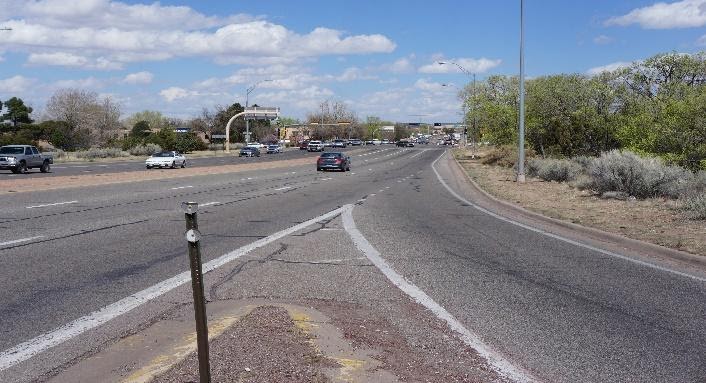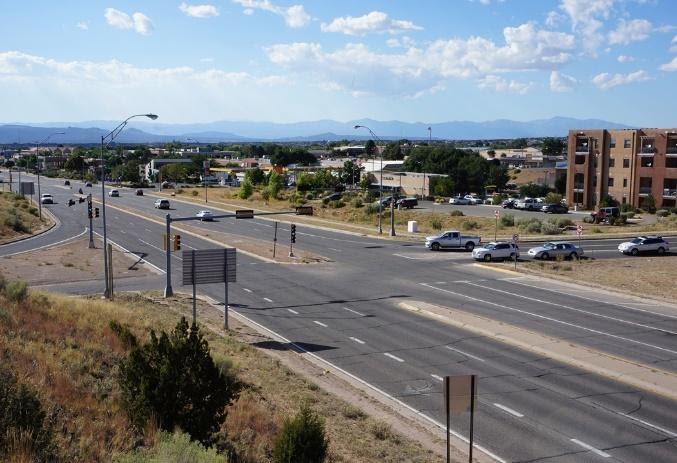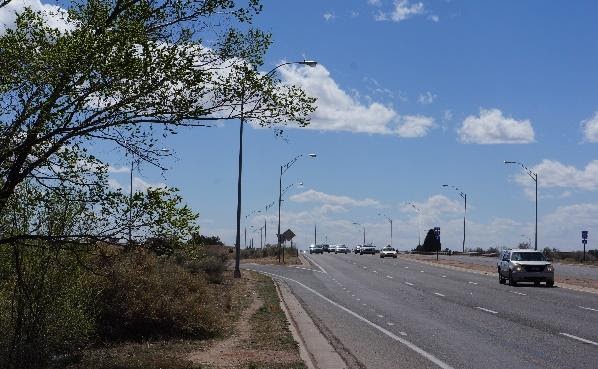The US 84/285 (St. Francis/St. Michael’s) Interchange Study (Study) in Santa Fe, New Mexico is sponsored by the New Mexico Department of Transportation (NMDOT) with funding from the Federal Highway Administration. The Study is centered on the St. Francis/St. Michaels Interchange, including St. Francis Drive (US 84/285) from Siringo Road to San Mateo Road and along St. Michael’s Drive (NM 466) from Pacheco Street to Galisteo Street (see vicinity map). The current Study is a continuation of the previous St. Francis/St. Michael’s – Interchange Alternatives Report (Phase IA), which was an initial screening evaluation to define purpose and need, identify alternative design solutions, and determine which were unfeasible and should be eliminated from further consideration. The current Phase IB Detailed Evaluation of Alternatives evaluates the remaining alternatives in greater detail and make recommendations for a preferred alternative.
Background
Purpose and Need Definition
The PURPOSE of the current Study is to address physical, operational, and safety deficiencies and to enhance pedestrian and bicycle connectivity through the Interchange area. Specific NEEDS include:
Physical Deficiencies
- Roadway: No merge lanes are provided on St. Francis Dr. at three existing on ramp locations. There is limited separation distance between existing ramp terminals and the West San Mateo and Galisteo Street intersections. Pavement is deteriorating along St. Francis Dr. and St. Michael’s Dr. and drainage infrastructure needs repair.

- Bridge 7336: The 45-year-old St. Francis Dr. Bridge has a substandard load rating, deficient load carrying capacity, low structural evaluation and sufficiency ratings, and is classified as “Structurally Deficient” and “Functionally Obsolete”. The limited deck width prohibits a merge lane from the existing cloverleaf on-ramp and the concrete box girder superstructure is not considered a good candidate for rehabilitation.

- Multi-Modal Facilities: East-west and north-south connectivity for pedestrians and bicycles is constrained throughout the interchange area. Transit services utilize and travel through the area.

Travel Demand and Congestion
- Localized congestion issues include deficient storage length at the existing cross street intersections where traffic queues extend beyond available storage areas and spill over into adjacent traffic lanes.
- Under future travel demand conditions, queue lengths are expected to increase, exasperating existing problem areas, and resulting in potential new locations of queue spillback.
Safety
- A high number of crashes within the interchange occur at four locations: 1). the southbound off-ramp/St. Michael’s Dr. intersection, 2). the southbound on-ramp to St. Francis Dr., 3). eastbound St. Michael’s Drive between the northbound off-ramp and Galisteo Street, and 4). the west to northbound on-ramp to St. Francis Dr. (view summary)
- Two additional hot spots were identified: 5). the stop-controlled intersection at the northbound off-ramp and St. Michael’s Dr. and 6). the northbound loop on-ramp to St. Francis Dr.
- A higher-than-expected crash frequency was identified at the four signalized cross street intersections adjacent to the interchange area.
- Three pedestrian crashes have occurred within the Study area. (view summary)

Alternatives Considered
The Phase IA St. Francis/St. Michael’s Interchange Alternatives Report (PDF) identified nine alternatives, including the No Build Alternative, and evaluated their comparative benefits and disadvantages. Based on the initial screening evaluation, the following alternatives were fount to be less feasible, and the Study Team recommended that they be eliminated from further evaluation.
- Re-stripe Existing St. Francis Drive: The Re-Striping Alternative would return the travel lane configuration along St. Francis Drive, from Siringo Road to West San Mateo, to the four lane configuration that existed before 2005 (view map).This would efficiently address the prominent merge lane deficiency that currently exists at the three on-ramps entering St. Francis Dr.; however, many deficiencies (e.g. physical, operational, safety, and multimodal) would remain and the new lane drops on St. Francis Dr. could induce operational and safety concerns.
- Modern Roundabout: This alternative would replace the existing bridge and interchange with an at-grade modern roundabout (view map). Although it addresses project needs, the roundabout would pose multi-lane complexity and driver expectancy/familiarity concerns and result in operational deficiencies under 2035 conditions.
- Single Point Urban Interchange (SPUI): This alternative would convert the existing interchange into a SPUI, with all on and off-ramp connections on St. Michael’s consolidated into a single signalized intersection (view map). The SPUI would address the Study purpose and need but would have significant impacts to traffic during construction and a high cost relative to other alternatives.
- Diverging Diamond Interchange (DDI): This alternative would convert the existing interchange into a DDI, with mainline eastbound and westbound traffic on St. Michael’s Dr. “crossed over” to eliminate left turn phases at the signalized ramp intersections (view map). The DDI alternative would address purpose and need but would result in an anticipated increase in crashes, severe impacts to traffic during construction, higher costs, and additional right-of-way requirements along St. Michael’s Dr.
At the conclusion of Phase IA, The Study Team recommended that the following alternatives be advanced for more detailed evaluation in Phase IB (Phase IB Report PDF):
- No-Build: The No-Build Alternative provides a basis upon which each of the initial build alternatives for the proposed interchange improvement project can be compared. This alternative would have no project-related impacts but does not address any physical, operational bicycle/pedestrian, or safety related deficiencies.
- Signalized Intersection: This alternative would replace the existing bridge and interchange with a conventional at-grade intersection at St. Francis Dr. and St. Michael’s Dr. (view map). The Signalized Intersection Alternative addresses Study purpose and need and provides for an at-grade alternative for comparison with interchange alternatives.
- Diamond Interchange: This alternative would convert the existing half diamond interchange into a full diamond configuration maintaining the grade separation of St. Francis Dr. over St. Michael’s Dr. (view map). The Diamond Interchange addresses Study needs and provides a greater range of potential benefits compared to other alternatives.
- Ramp Reconfiguration: The Ramp Reconfiguration Alternative would improve the on- and off-ramps on the east side of the interchange, replacing the two existing northbound on-ramps with a single “trumpet” style ramp (view map). This alternative addresses Study needs and provides greater potential benefits compared to other alternatives.
- Split Bridge Northbound/Southbound Left-on Access: This alternative would convert the existing interchange into a split bridge configuration, with the St. Francis Dr. mainline split to cross over St. Michael’s Dr. on two new structures. On-ramps from St. Michael’s Dr. would access St. Francis Dr. on the left (view map). It addresses project needs but provides an inferior range of benefits compared to
other alternatives.
In addition to these alternatives, the Phase IB Study included an alternative whereby St. Michael’s Dr. would be constructed as a four-lane roadway within the interchange, in recognition of on-going City of Santa Fe planning efforts to undertake a future road diet study on St. Michael’s Dr. (view image) Several minor intersection alternatives were also considered at Siringo Road/St. Francis Dr., West San Mateo Road/St. Francis Dr., and the southbound off-ramp intersection at St. Michael’s Dr.
Phase IB Recommended Alternative
Based upon the detailed evaluation, the Phase IB recommended alternative is the Ramp Reconfiguration with the four-lane option on St. Michael’s Drive and the Siringo Road/St. Francis Dr. intersection configured to include dual left-turn lanes from northbound St. Francis Dr. to westbound Siringo Road (view map).

